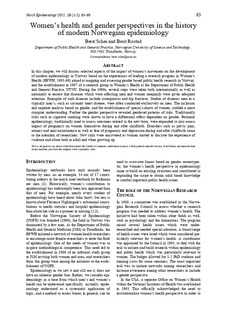| dc.contributor.author | Schei, Berit | |
| dc.contributor.author | Rostad, Berit | |
| dc.date.accessioned | 2019-11-25T06:59:04Z | |
| dc.date.available | 2019-11-25T06:59:04Z | |
| dc.date.created | 2015-09-11T10:25:38Z | |
| dc.date.issued | 2015 | |
| dc.identifier.citation | Norsk Epidemiologi. 2015, 25 (1-2), 63-69. | nb_NO |
| dc.identifier.issn | 0803-2491 | |
| dc.identifier.uri | http://hdl.handle.net/11250/2630152 | |
| dc.description.abstract | In this chapter, we will discuss selected aspects of the impact of women’s movement on the development
of modern epidemiology in Norway based on the experiences of leading a research program in Women’s
Health (RPWH, 1991-96) aimed at mapping and assessing gender based public health research in Norway, and the establishment in 1997 of a research group in Women’s Health at the Department of Public Health and General Practice, NTNU. During the 1990s, several steps were taken both internationally as well as nationally to ensure that diseases which were affecting men and women unequally were given adequate attention. Examples of such diseases include osteoporosis and hip fractures. Studies of diseases seen as a typically men’s, such as coronary heart disease, were often conducted exclusively on men. The inclusion and separate analysis based on gender, and the establishment of special cohorts of women, yielded a more complex understanding. Further the gender perspective revealed gendered patterns of risks. Traditionally risks such as cigarette smoking were shown to have a differential effect dependent on gender. Perinatal epidemiology, traditionally used to assess outcomes related to the new-born, were expanded to also assess impact of pregnancy on women themselves during and after childbirth. Disorders such as pelvic pain, urinary and anal incontinence as well as fear of pregnancy and depression during and after childbirth came to the attention of researchers. New risks were uncovered as women started to disclose the experience of violence and abuse both as adult and when growing up. | nb_NO |
| dc.language.iso | eng | nb_NO |
| dc.publisher | Norwegian Epidemiological Association (NOFE) | nb_NO |
| dc.relation.uri | http://www.ntnu.no/ojs/index.php/norepid/article/view/1891/1890 | |
| dc.rights | Navngivelse 4.0 Internasjonal | * |
| dc.rights.uri | http://creativecommons.org/licenses/by/4.0/deed.no | * |
| dc.title | Women’s health and gender perspectives in the history of modern Norwegian epidemiology | nb_NO |
| dc.type | Journal article | nb_NO |
| dc.type | Peer reviewed | nb_NO |
| dc.description.version | publishedVersion | nb_NO |
| dc.source.pagenumber | 63-69 | nb_NO |
| dc.source.volume | 25 | nb_NO |
| dc.source.journal | Norsk Epidemiologi | nb_NO |
| dc.source.issue | 1-2 | nb_NO |
| dc.identifier.cristin | 1263458 | |
| dc.description.localcode | This is an open access article distributed under the Creative Commons Attribution Licence, which permits unrestricted use, distribution, and reproduction in any medium, provided the original work is properly cited. | nb_NO |
| cristin.unitcode | 194,65,20,0 | |
| cristin.unitname | Institutt for samfunnsmedisin og sykepleie | |
| cristin.ispublished | true | |
| cristin.fulltext | original | |
| cristin.qualitycode | 1 | |

